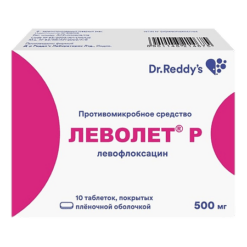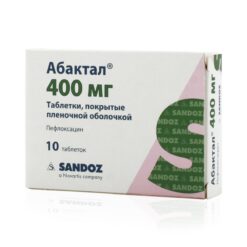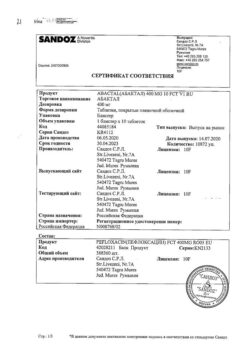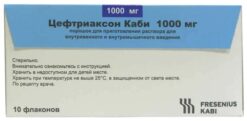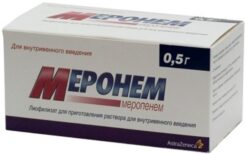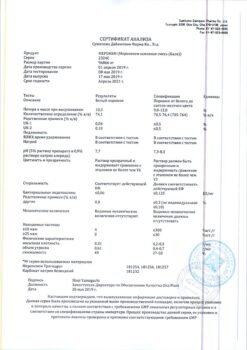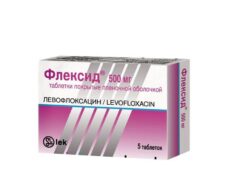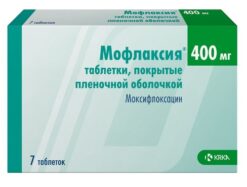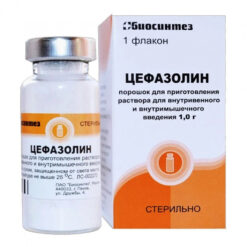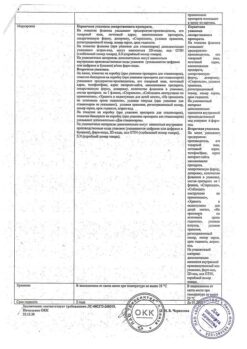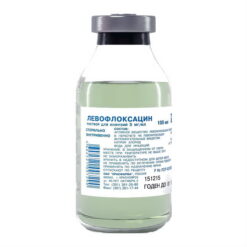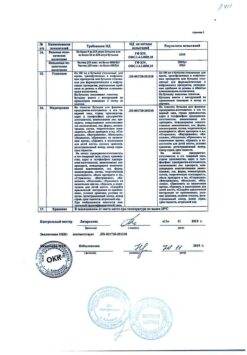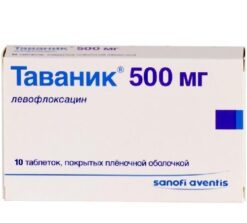No products in the cart.
Levolet R, 5 mg/ml 100 ml
€1.00
Out of stock
(E-mail when Stock is available)
Description
Pharmacological action – broad spectrum antimicrobial, bactericidal.
Pharmacodynamics
Blocks DNA-Giase (topoisomerase II) and topoisomerase IV, breaks superspiralization and cross-linking of DNA breaks, inhibits DNA synthesis, causes profound morphological changes in the cytoplasm, cell wall and membranes.
Levofloxacin is active against the following strains of microorganisms, both in vitro and in vivo.
Sensitive microorganisms (minimum suppressive concentration – MAC – ≤2 mg/ml)
Aerobic Gram-positive microorganisms: Corynebacterium diphtheriae, Enterococcus faecalis, Enterococcus spp, Listeria monocytogenes, Staphylococcus coagulase-negative methi-S(I) (methicillin-sensitive/moderately sensitive strains), Staphylococcus aureus methi-S (methicillin-sensitive strains), Staphylococcus epidermidis methi-S (methicillin-sensitive strains), Staphylococcus spp. (CNS – leukotoxin-containing), Streptococci of groups C and G (including Streptococcus agalactiae, Streptococcus pneumoniae peni-S/I/R (penicillin-sensitive / moderately sensitive / resistant strains), Streptococcus pyogenes, Viridans streptococci peni-S/R (penicillin-sensitive / resistant strains).
Aerobic Gram-negative microorganisms: Acinetobacter baumannii, Acinetobacter spp, Actinobacillus actinomycetemcomitans, Citrobacter freundii, Eikenella corrodens, Enterobacter aerogenes, Enterobacter agglomerans, Enterobacter spp. Enterobacter cloacae), Escherichia coli, Gardnerella vaginalis, Haemophilus ducreyi, Haemophilus influenzae ampi-S/R (ampicillin sensitive/resistant strains), Haemophilus parainfluenzae, Helicobacter pylori, Klebsiella spp. Klebsiella oxytoca, Klebsiella pneumoniae), Moraxella catarrhalis β+/β- (β-lactamase producing and non-producing strains), Morganella morganii, Neisseria gonorrhoeae non-PPNG/PPNG (penicillinase producing and non-producing strains), Neisseria meningitidis, Pasteurella spp. (including Pasteurella canis, Pasteurella dagmatis, Pasteurella multocida), Proteus mirabilis, Proteus vulgaris, Providencia spp. (including Providencia rettgeri, Providencia stuartii), Pseudomonas spp. (including Pseudomonas aeruginosa), Serratia spp. (including Serratia marcescens), Salmonella spp.
Anaerobic microorganisms: Bacteroides fragilis, Bifidobacterium spp., Clostridium perfringens, Fusobacterium spp., Peptostreptococcus spp., Propionibacterium spp., Veillonella spp.
Other microorganisms: Bartonella spp., Chlamydia pneumoniae, Chlamydia psittaci, Chlamydia trachomatis, Legionella pneumophila, Legionella spp, Mycobacterium spp. (including Mycobacterium leprae, Mycobacterium tuberculosis), Mycoplasma hominis, Mycoplasma pneumoniae, Rickettsia spp., Ureaplasma urealyticum.
Moderately susceptible microorganisms (MPC ≥4 mg/l)
Aerobic Gram-positive microorganisms: Corynebacterium urealyticum, Corynebacterium xerosis, Enterococcus faecium, Staphylococcus epidermidis methi-R (methicillin-resistant strains), Staphylococcus haemolyticus methi-R (methicillin-resistant strains).
Aerobic gram-negative microorganisms: Burkholderia cepacia, Campylobacter jejuni, Campylobacter coli.
Anaerobic microorganisms: Bacteroides thetaiotaomicron, Bacteroides vulgatus, Bacteroides ovatus, Prevotella spp., Porphyromonas spp.
Resistant microorganisms (MPC ≥8 mg/L)
Aerobic Gram-positive microorganisms: Corynebacterium jeikeium, Staphylococcus aureus methi-R (methicillin-resistant strains), Staphylococcus coagulase-negative methi-R (coagulase-negative methicillin-resistant strains).
Aerobic Gram-negative microorganisms: Alcaligenes xylosoxidans.
Other microorganisms: Mycobacterium avium.
Pharmacokinetics
The pharmacokinetics of levofloxacin with single and multiple administration of the drug has a linear character. Plasma concentration profile of levofloxacin after intravenous administration is similar to that of tablets. Therefore, oral and intravenous routes of administration may be considered interchangeable.
After single and multiple intravenous administration at a dose of 500 mg, the Vd of levofloxacin is 89 to 112 liters. After an hour’s infusion of 500 mg levofloxacin in healthy volunteers the mean value of Cmax in plasma was (6.2±1) mcg/ml, Tmax was (1±0.1) hours.
In oral administration it is quickly and almost completely absorbed (food intake has little effect on the speed and completeness of absorption). Bioavailability – 99%. Tmax is 1-2 h; when administered in 250 and 500 mg the average Cmax is 2.8 and 5.2 mcg/ml, respectively.
The binding to plasma proteins is 30-40%. It penetrates well into organs and tissues: lungs, bronchial mucosa, sputum, urogenital organs, polymorphonuclear leukocytes, alveolar macrophages. In the liver, a small portion is oxidized and/or deacetylated.
Extracted from the body mainly by the kidneys through glomerular filtration and tubular secretion. After a single 500 mg intravenous injection the T1/2 is (6.4±0.7) hours, when taking tablets the T1/2 is 6-8 hours. Renal clearance is 70% of total clearance. Less than 5% of levofloxacin is excreted as metabolites. In urine over 24 hours 70% of the administered dose is found unchanged, and over 48 hours – 87%. In feces over a period of 72 hours 4% of the administered dose is detected. In renal insufficiency, the decrease in clearance of the drug and its excretion by the kidneys depends on the degree of decrease in Cl creatinine.
Indications
Indications
Infectious and inflammatory diseases of mild to moderate severity caused by pathogens sensitive to the drug:
– community-acquired pneumonia;
– drug-resistant forms of tuberculosis (as part of complex therapy);
– complicated kidney and urinary tract infections, including pyelonephritis;
– uncomplicated urinary tract infections;
– prostatitis, incl. bacterial;
– septicemia/bacteremia associated with the above indications;
– intra-abdominal infection.
Pharmacological effect
Pharmacological effect
Pharmacological action – broad spectrum antimicrobial, bactericidal.
Pharmacodynamics
Blocks DNA gyrase (topoisomerase II) and topoisomerase IV, disrupts supercoiling and cross-linking of DNA breaks, suppresses DNA synthesis, causes profound morphological changes in the cytoplasm, cell wall and membranes.
Levofloxacin is active against the following strains of microorganisms, both in vitro and in vivo.
Sensitive microorganisms (minimum inhibitory concentration – MIC – ≤2 mg/ml)
Aerobic gram-positive microorganisms: Corynebacterium diphtheriae, Enterococcus faecalis, Enterococcus spp., Listeria monocytogenes, Staphylococcus coagulase-negative methi-S(I) (methicillin-sensitive/moderately sensitive strains), Staphylococcus aureus methi-S (methicillin-sensitive strains), Staphylococcus epidermidis methi-S (methicillin-sensitive strains), Staphylococcus spp. (CNS – leukotoxin-containing), Streptococci groups C and G (including Streptococcus agalactiae, Streptococcus pneumoniae peni-S/I/R (penicillin-sensitive/moderately sensitive/resistant strains), Streptococcus pyogenes, Viridans streptococci peni-S/R (penicillin-sensitive/resistant strains).
Aerobic gram-negative microorganisms: Acinetobacter baumannii, Acinetobacter spp., Actinobacillus actinomycetemcomitans, Citrobacter freundii, Eikenella corrodens, Enterobacter aerogenes, Enterobacter agglomerans, Enterobacter spp. (including Enterobacter cloacae), Escherichia coli, Gardnerella vaginalis, Haemophilus ducreyi, Haemophilus influenzae ampi-S/R (ampicillin-sensitive/resistant strains), Haemophilus parainfluenzae, Helicobacter pylori, Klebsiella spp. (including Klebsiella oxytoca, Klebsiella pneumoniae), Moraxella catarrhalis β+/β- (beta-lactamase-producing and non-producing strains), Morganella morganii, Neisseria gonorrhoeae non-PPNG/PPNG (penicillinase-producing and non-producing strains), Neisseria meningitidis, Pasteurella spp. (including Pasteurella canis, Pasteurella dagmatis, Pasteurella multocida), Proteus mirabilis, Proteus vulgaris, Providencia spp. (including Providencia rettgeri, Providencia stuartii), Pseudomonas spp. (including Pseudomonas aeruginosa), Serratia spp. (including Serratia marcescens), Salmonella spp.
Anaerobic microorganisms: Bacteroides fragilis, Bifidobacterium spp., Clostridium perfringens, Fusobacterium spp., Peptostreptococcus spp., Propionibacterium spp., Veillonella spp.
Other microorganisms: Bartonella spp., Chlamydia pneumoniae, Chlamydia psittaci, Chlamydia trachomatis, Legionella pneumophila, Legionella spp., Mycobacterium spp. (including Mycobacterium leprae, Mycobacterium tuberculosis), Mycoplasma hominis, Mycoplasma pneumoniae, Rickettsia spp., Ureaplasma urealyticum.
Moderately sensitive microorganisms (MIC ≥4 mg/l)
Aerobic gram-positive microorganisms: Corynebacterium urealyticum, Corynebacterium xerosis, Enterococcus faecium, Staphylococcus epidermidis methi-R (methicillin-resistant strains), Staphylococcus haemolyticus methi-R (methicillin-resistant strains).
Aerobic gram-negative microorganisms: Burkholderia cepacia, Campylobacter jejuni, Campylobacter coli.
Anaerobic microorganisms: Bacteroides thetaiotaomicron, Bacteroides vulgatus, Bacteroides ovatus, Prevotella spp., Porphyromonas spp.
Resistant microorganisms (MIC ≥8 mg/l)
Aerobic gram-positive microorganisms: Corynebacterium jeikeium, Staphylococcus aureus methi-R (methicillin-resistant strains), Staphylococcus coagulase-negative methi-R (coagulase-negative methicillin-resistant strains).
Aerobic gram-negative microorganisms: Alcaligenes xylosoxidans.
Other microorganisms: Mycobacterium avium.
Pharmacokinetics
The pharmacokinetics of levofloxacin with single and repeated administration of the drug is linear. The plasma profile of levofloxacin concentrations after intravenous administration is similar to that when taking tablets. Therefore, oral and intravenous routes of administration can be considered interchangeable.
After single and multiple intravenous administration at a dose of 500 mg, the Vd of levofloxacin ranges from 89 to 112 l. After an intravenous one-hour infusion of levofloxacin at a dose of 500 mg to healthy volunteers, the average Cmax in plasma was (6.2 ± 1) μg/ml, Tmax – (1 ± 0.1) hours.
When taken orally, it is quickly and almost completely absorbed (food intake has little effect on the speed and completeness of absorption). Bioavailability – 99%. Tmax – 1–2 hours; when taking 250 and 500 mg, the average Cmax value is 2.8 and 5.2 μg/ml, respectively.
Plasma protein binding is 30–40%. Penetrates well into organs and tissues: lungs, bronchial mucosa, sputum, genitourinary organs, polymorphonuclear leukocytes, alveolar macrophages. In the liver, a small portion is oxidized and/or deacetylated.
It is excreted from the body primarily by the kidneys by glomerular filtration and tubular secretion. After a single intravenous administration at a dose of 500 mg, T1/2 is (6.4±0.7) hours, when taking T1/2 tablets – 6-8 hours. Renal clearance is 70% of the total clearance. Less than 5% of levofloxacin is excreted as metabolites. In urine over a period of 24 hours, 70% of the administered dose is found unchanged, and over 48 hours – 87%. In feces over a period of 72 hours, 4% of the administered dose is detected. In case of renal failure, a decrease in the clearance of the drug and its excretion by the kidneys depends on the degree of decrease in creatinine Cl.
Special instructions
Special instructions
Treatment with levofloxacin is recommended to be continued for at least 48–72 hours after normalization of body temperature or after reliable eradication of the pathogen. During treatment, it is necessary to avoid solar and artificial UV irradiation to avoid damage to the skin (photosensitization). If signs of tendonitis or pseudomembranous colitis appear, levofloxacin is immediately discontinued.
It should be borne in mind that in patients with a history of brain damage (stroke, severe head injury), seizures may develop; in patients with glucose-6-phosphate dehydrogenase deficiency, there is a risk of hemolysis.
For severe pneumonia caused by Streptococcus pneumoniae, levofloxacin may not be effective.
IV administration should be carried out for at least 60 minutes; during administration, palpitations and a transient decrease in blood pressure may be noted; collapse may rarely develop. If there is a significant decrease in blood pressure, the administration of levofloxacin is stopped. If the development of pseudomembranous colitis caused by Clostridium difficile is suspected, treatment with levofloxacin is canceled and appropriate therapy is prescribed.
Impact on the ability to drive a car or perform work that requires increased speed of physical and mental reactions. During the treatment period, care must be taken when driving vehicles and engaging in other potentially hazardous activities that require increased concentration and speed of psychomotor reactions.
Active ingredient
Active ingredient
Levofloxacin
Composition
Composition
100 ml of solution contains:
Active ingredient:
levofloxacin hemihydrate 512 mg, equivalent to 500 mg levofloxacin.
Excipients:
dextrose 5000 mg,
hydrochloric acid 0.117 ml,
sodium hydroxide 2.857 mg,
water for injections up to 100 ml.
Contraindications
Contraindications
– hypersensitivity to levofloxacin or other quinolones;
– hypersensitivity to the auxiliary components of the drug;
– epilepsy;
– history of tendon lesions associated with taking quinolones;
– children and adolescents up to 18 years of age;
– pregnancy;
– lactation period (breastfeeding).
With caution: older age (high likelihood of concomitant decline in renal function); glucose-6-phosphate dehydrogenase deficiency
Side Effects
Side Effects
The incidence of side effects is classified depending on the frequency of occurrence: often (1–10%); sometimes (less than 0.1–1%); rarely (0.01–0.1%); very rare (less than 0.01%), including isolated reports.
From the blood system and hematopoietic organs: sometimes – eosinophilia, leukopenia; rarely – neutropenia, thrombocytopenia; very rarely – severe agranulocytosis; in some cases – hemolytic anemia, pancytopenia.
From the digestive system: often – nausea, diarrhea, increased activity of ALT, AST, dysbacteriosis; sometimes – loss of appetite, vomiting, abdominal pain, digestive disorders, hyperbilirubinemia; rarely – diarrhea mixed with blood (in very rare cases this may be a sign of intestinal inflammation or pseudomembranous colitis); very rarely – hepatitis.
From the cardiovascular system: rarely – tachycardia, decreased blood pressure; very rarely – vascular collapse; in some cases – prolongation of the QT interval.
From the central and peripheral nervous system: sometimes – headache, dizziness, stiffness of movement, drowsiness, sleep disturbance; rarely – paresthesia in the hands, trembling, anxiety, states of fear, seizures, confusion; very rarely – psychotic reactions such as hallucinations and depression, movement disorders.
From the senses: very rarely – disturbances in vision and hearing, smell, taste and tactile sensitivity.
On the metabolic side: very rarely – hypoglycemia (manifested by a sharp increase in appetite, nervousness, perspiration, trembling); in some cases – exacerbation of existing porphyria.
From the urinary system: rarely – hypercreatininemia; very rarely – deterioration of kidney function up to acute renal failure (for example, due to allergic reactions – interstitial nephritis).
From the musculoskeletal system: rarely – tendon damage (including tendonitis), joint and muscle pain; very rarely – tendon ruptures (including Achilles, which can be bilateral and appear within 48 hours after the start of treatment), muscle weakness (of particular importance for patients with myasthenia gravis); in some cases – rhabdomyolysis.
Allergic reactions: sometimes – itching and redness of the skin; rarely – anaphylactic and anaphylactoid reactions (manifested by symptoms such as urticaria, bronchospasm and possible severe suffocation, and also in rare cases – swelling of the face and larynx); very rarely – a sharp decrease in blood pressure, anaphylactic shock; in some cases – Stevens-Johnson syndrome, toxic epidermal necrolysis (Lyell’s syndrome) and exudative erythema multiforme, allergic pneumonitis, vasculitis.
Dermatological reactions: very rarely – photosensitivity.
Other: sometimes – asthenia; very rarely – persistent fever, development of superinfection.
Additionally for solution for infusion
Local reactions: often – pain, redness, phlebitis.
Interaction
Interaction
Increases T1/2 of cyclosporine.
NSAIDs, theophylline increase convulsive readiness, corticosteroids increase the risk of tendon rupture.
Cimetidine and drugs that block tubular secretion slow down excretion.
Additionally for film-coated tablets
The completeness of absorption is reduced by drugs that inhibit intestinal motility, sucralfate, antacid drugs containing aluminum and magnesium salts, as well as drugs containing iron salts (a break between doses of at least 2 hours is required).
Additionally for solution for infusion
When used simultaneously with indirect anticoagulants (including warfarin), it is necessary to monitor blood clotting.
Overdose
Overdose
Symptoms: nausea, erosive lesions of the mucous membranes of the gastrointestinal tract, prolongation of the QT interval, confusion, dizziness, convulsions.
Treatment: symptomatic, dialysis is ineffective.
Storage conditions
Storage conditions
In a place protected from light at a temperature not exceeding 25 °C.
Do not freeze.
Keep out of the reach of children!
Shelf life
Shelf life
2 years.
Manufacturer
Manufacturer
Dr. Reddy’s Laboratories Ltd, India
Additional information
| Shelf life | 2 years. |
|---|---|
| Conditions of storage | In the dark place at temperatures not exceeding 25 ° C. Do not freeze. Keep out of reach of children! |
| Manufacturer | Dr. Reddy's, India |
| Medication form | solution for infusion |
| Brand | Dr. Reddy's |
Other forms…
Related products
Buy Levolet R, 5 mg/ml 100 ml with delivery to USA, UK, Europe and over 120 other countries.


